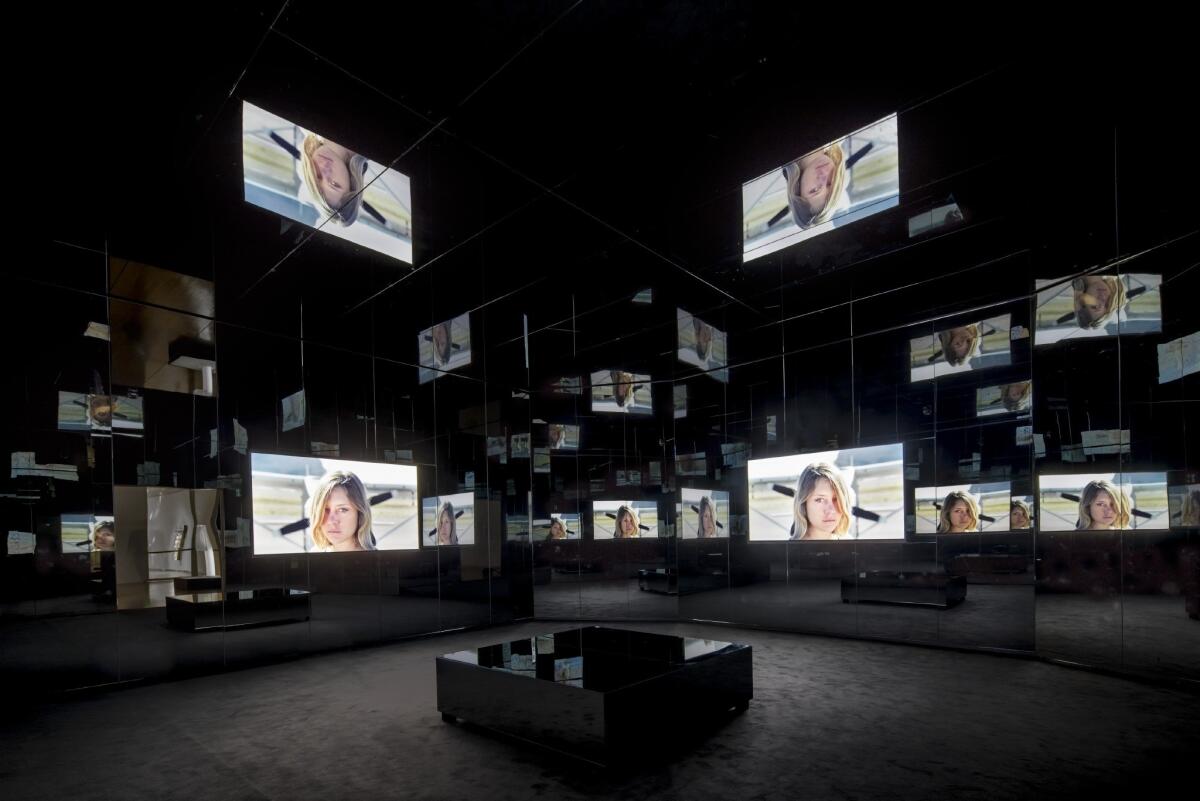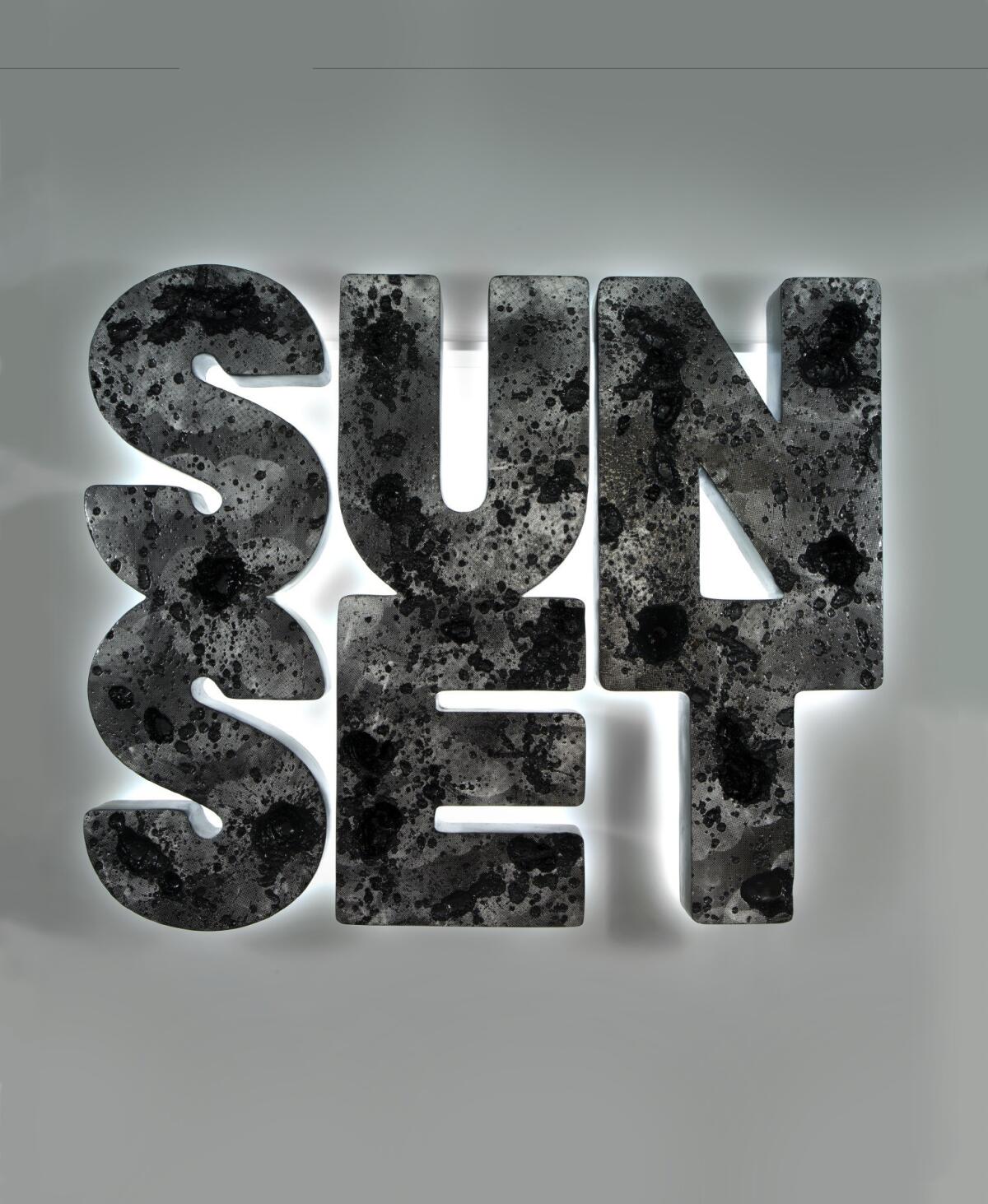Review: ‘Doug Aitken: Electric Earth’: Why MOCA’s big new show has too few sparks
- Share via
Smashed hopes, lost love, inevitable decay and social dissolution, all within a seamless Mobius strip of passing time — Doug Aitken’s work in sculpture and immersive video installations during the past 20 years has taken a romantic view of life’s predictable unraveling. Usually the musing is wrapped in a sleek, even slick package of easily consumable commercial design.
And too often, unfortunately, it is undone by a grating aura of chic ennui.
“Doug Aitken: Electric Earth,” a large survey of the Los Angeles artist’s career at the Geffen Contemporary, the Museum of Contemporary Art’s Little Tokyo outpost, was organized by director Philippe Vergne and includes sculptures, collages, photographs and project documentation. Seven large-scale, moving-image installations anchor the event.
The title work, “Electric Earth” (1999), remains Aitken’s most compelling piece. MOCA acquired the eight-channel, multiroom video projection the year it was made — it won that year’s International Prize at the Venice Biennale — and the installation was a high point when presented at the 2000 Whitney Biennial in New York. Its dreamy, nonlinear narrative of urban isolation seemed to herald the arrival of an important new voice.
A lone young man, intermittently jittery, traverses a deserted, nighttime Los Angeles, sliding past brightly lighted discount stores and across shadowed parking garages. He seems propelled by an unseen power source — something along the quixotic lines of Henri Bergson’s mysterious, unknowable élan vital.
Projected onto multiple screens in a series of four permeable chambers, images of the city are corralled and contained within confined interior spaces. As the young man roams, his intermittent shaking and tumbling unfolds as a faceted metaphor for sudden trauma, blissful aesthetic reverie and sudden bursts of intuitive perception within drifting consciousness.
The work’s energizing correspondence between mundane subjects and the fluidity of camera work later gets pictured in “99 cents dreams” from 2008, a room filled with a gridded installation of 216 snapshot-like photographs of ordinary scenes: a kitchen ceiling light, sky glimpsed through airplane windows, a layer of snow on a parked motorcycle, a prickly and penis-shaped cactus, the shoreline, desert sands. Most are related to air, water and light, but individually and collectively they’re dull.
The “99 cents” motif repeats discount-store images from “Electric Earth,” one of many examples of Aitken’s art circling back on itself. Circles, in fact, are themselves a recurrent motif, partly suggesting the shape of his camera’s lens. But the slowly emerging discovery of fluid connections among disparate pictures mostly produces a shrug.
SIGN UP for the free Essential Arts & Culture newsletter »
By contrast, Aitken’s other memorable work is a single-channel video first shown at Pittsburgh’s prestigious Carnegie International in 2005. The centerpiece shows wild animals one by one — bison, owl, cougar, horse, etc. — incongruously caged inside motel rooms in a remote wilderness location.
The motel, a transient habitat for roaming humans, is temporarily occupied by denizens of a world that humanity has pushed aside.
Aitken’s style is frankly commercial — “migration (empire)” could be a Dolce & Gabbana perfume ad or a Vogue magazine spread — but pointedly without the product pitch. Animals become surrogates for people bumbling about inside culture’s fabrications.
In Pittsburgh, “migration” was shown to good effect in a small theater. At the Geffen, Aitken projects it in quadruplicate on four industrial-strength, double-sided billboards. He often reconfigures compositions, but here the inflation to a commercial communication format is unfortunate; subtle, elegant poetics become a kitschy harangue. The work now feels like space-filler for a vast gallery.
Distended spectacle overtakes much of Aitken’s work from the last decade.

“Black Mirror” (2011) is a disorienting, octagonal mirrored room. Its video imagery of a rootless drifter (actress and clothing designer Chloë Sevigny) terminally disconnected in spite (or perhaps because) of our communication-stuffed environment is reflected into a kaleidoscopic, Cubist-style infinity.
“Song I,” projected on a big, circular scrim, is a variation on 2012’s outdoor projection on the facade of Washington, D.C.’s doughnut-shaped Hirshhorn Museum. The video scans soulful young things (and seemingly translucent actress Tilda Swinton) lip-synching to the Flamingos’ sophisticated, 1959 doo-wop version of the Depression-era song “I Only Have Eyes for You,” which later helped anchor “American Graffiti,” George Lucas’ satiny 1973 movie of aimlessly cruising youth. Suddenly it explodes into a tribal, psychedelic frenzy.
Aitken’s background in magazine illustration and commercial graphic design is used to obvious stylistic effect. It’s a risky business, though. The artist’s 21st century trajectory records a period in which galloping commerce has overtaken the art experience — not merely in the marketplace, but also in museums.
Symptomatic is the show’s disappointing catalog. A mostly attractive picture book with short object-entries and several light essays, it’s without the standard chronological analysis of traditional museum scholarship.
The museum has been pretty sleepy since its near-death experience at the edge of a fiscal cliff three years ago, and two Geffen extravaganzas since then have been showy pop spectacles produced by male multimedia artists — first Matthew Barney, now Aitken. (Both are even represented by the same L.A. gallery, the esteemed Regen Projects.) These museum shortcomings are partial testament to market authority.
Unlike art, a ballooning marketplace is confined and narrow, dependent for success on straightforward popularity. MOCA is starting to appear to be hooked.

Aitken’s work draws on many other artists — text and image paintings by Ed Ruscha; video ruminations on animal intelligence by Diana Thater (Aitken’s fellow student at Art Center College in the late 1980s); Bruce Nauman’s insistent demand to audiences to “Please Pay Attention,” repeated in an Aitken light-box; Bill Viola’s technical video-theatrics; Jack Pierson’s faded wall texts composed from scavenged commercial signage; the mirrored sculptures of Robert Smithson, avatar of entropy; Yayoi Kusama’s infinity chambers, and more.
Aitken mixes those and other strategies of fine and commercial art. Wall signs — “Sunset,” “100 YRS,” “MORE,” “1968” (this last recording social turmoil during the artist’s birth year) — advertise the same allusions to transformation and mortality also broached in the immersive videos.
The overarching theme is Modernism within the passing of a dominant, analog world and the rise of a digital empire. We’ve been buffeted by that vertiginous metamorphosis for a generation. But Aitken’s mostly gossamer-thin digital dirges offer scant solace for what’s been lost and less joy in the new adventure.
------------
‘Doug Aitken: Electric Earth’
Where: Geffen Contemporary, 152 N. Central Ave., L.A.
When: Through Jan. 15; closed Tuesdays
Information: (213) 626-6222, www.moca.org
Twitter: @KnightLAT
ALSO
11 don't-miss art exhibitions for fall: Quaytman, McLaughlin and a 'Shimmer of Gold'
Review: 'Alternative Dreams: 17th Century Chinese Paintings From the Tsao Collection' at LACMA
Doug Aitken to install 'Underwater Pavilions' this fall
Feature: Doug Aitken's 'Electric Earth' will shake the MOCA landscape
The biggest entertainment stories
Get our big stories about Hollywood, film, television, music, arts, culture and more right in your inbox as soon as they publish.
You may occasionally receive promotional content from the Los Angeles Times.








